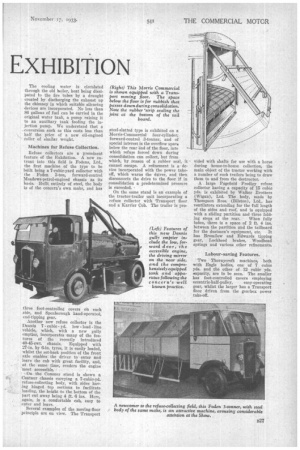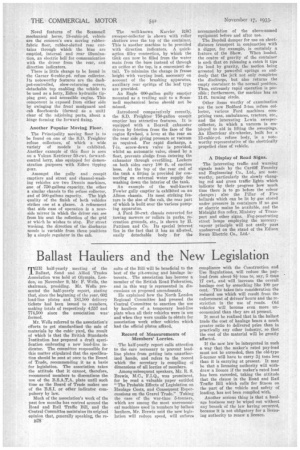Comments on the
Page 40

Page 41

Page 42

If you've noticed an error in this article please click here to report it so we can fix it.
ROADS and TRANSPORT
EXHIBITION
Salient Features Revealed by a Stand-to-stand Inspection of the Vehicles and Appliances at an Important Event
IN our issue for last week we dealt, in stand-to-stand form, with the comprehensive range of vehicles and appliances to be shown at the Public Works, Roads and Transport Exhibition now being held at the Royal Agricultural Hall, London, until the end of this week. Our comments were necessarily brief, and described general features, but in the commentary that follows we enumerate points of special interest and novelty, after making a first-hand inspection of the machines.
In view of the fact that the existence of roads is essential to this industry, the machines used in their construction —or at least those examples that fall within the scope of this paper—seem to deserve precedence.
Many Road Rollers.
The most comprehensive display of road rollers is that on the stand of Barford and Perkins and Aveling and Porter, Ltd. All finished in cream and black, the machines include petrol, oil and steam rollers, of from 12it cwt. to 14 tons. The largest is of the Aveling type, having a low-speed, horizontal one-cylintlered oil engine, a feature more or less characteristic, whilst the Barford type is mainly equipped with
vertical, faster-running engines. Another distinguishing feature is the use of the transverse, front-roll bridge on the Aveling machines and the foreand-aft bridge with uderslung forecarriage on the latter type.
Steam and oil rollers of the Advance type are exhibited by Wallis and Steevens, Ltd., the 101-ton maphine now employing a National three-cylindered oil engine.
An interesting feature of the 2-21-ton roller made by Ruston and Hornsby, Ltd., is the starting ystem used on the Lister one-cylindered oil engine. Briefly, it 'C'omprises a variable compression device,the .orifice of an air cell in the combustion chamber being closed by a valve to raise the compression for initial firing of the charge.
Marshall 4-ton and 10-ton rollers now employ Blackstone one and threecylindered cold-starting engines re
B26
spectively. A feature of the design of
• both is the construction of the frame, which is formed basically of two -steel plates. The interesting three-speed gearbox is shown separately, being provided with a glass top to reveal its mechanism and massive construction. A. noteworthy, point is -thearrangement by which the scarifiers may be ' used in any one of four positions across the width of road traversed.
• An Aveling and Porter steam roller, ittid to be 34 years old, converted to run on oil, is shown by ,John Allen and Sons (Oxford), Ltd. In Place of the original steam unit is a 31 b.h.p. horizontal cartridge-starting oil engine geared through a forward-and-reverse layshaft to the equivalent of the old crankshaft, the first and second-motion shafts being unchanged. The cooling water is circulated through the old boiler, beat being dissipated to the fire tubes by a draught created by discharging the exhaust up the chimney in which suitable silencing devices are incorporated. No less than 8(1 gallons of fuel can be carried in the original water tank, a pump raising it to an auxiliary tank feeding the injection pump. We understand that a conversion such as this costs less than half the price of a new oil-engined roller of similar weight.
Machines for Refuse Collection.
Refuse collectors are a prominent feature of the Exhibition. A new entrant into this field is Fodens, Ltd., the first machine of the type to be built being a 7-cubic-yard collector with the Foden 3-ton, forward-control Meadows-petrol-engined chassis as its basis. Built entirely of steel, the body is of the concern's own make, and has three foot-controlled covers on each side, and Spenborough hand-operated, end-tipping gear.
Another new refuse collector is the Dennis 7 cubic yd. low -load line vehicle, which, with a new gully emptier, incorporates many of the features of the recently introduced 40-45-cwt. chassis. Equipped with 27-in. by 6-in. tyres, it is easily loaded, whilst the set-back position of the front axle enables the driver to enter and leave the cab with great facility, and, at the same time, renders the engine most accessible.
On the Commer stand is shown a Centaur chassis carrying a 7-cubic-yd. refuse-collecting body, with sides having hinged top sections to facilitate loading, the height to the bottom of the part cut away being 4 ft. 6 ins. Here, again, is a comfortable cab, easy to enter and leave.
Several examples of the moving-floor principle are on view. The Transport
steel-slatted type is exhibited on a Morris-Commercial four-cylinder, forward-control 8-tonner, and of special interest is the overflow space below the rear -6nd of the floor, into which refuse forced down during consolidation can collect, but from which, by reason of a rubber seal, it cannot escape. A refinement is a device incorporated with the power takeoff, which warns the dtiver, and then disconnects the drive to the floor if in consolidation a predetermined pressure is exceeded.
On the same stand is an example of the tractor-trailer unit incorporating a refuse collector with Transport floor and a Karrier Cob. The trailer is pro vided with shafts for use with a horse during house-to-house collection, the main object of the tractor working with a number of such trailers being to draw them to and from the destructor.
A large Pagefield Prodigy refuse collector having a capacity of 15 cubic yds. is exhibited by Walker Brothers (Wigan), Ltd. The body, made by Thompson Bros. (Bilston), Ltd., has ventilators extending for the full length of the sides and roof, and is equipped with a sliding partition and three fold ing steps at the rear. When fully laden, there is a space of 2 ft. 4 ins. between the partition and the tailboard for the dustmen's equipment, etc. It has Bromilow and Edwards tipping gear, Lockheed brakes, Woodhead springs and various other refinements.
Labour-saving Features.
Two Thornycroft machine.s' both with Eagle bodies, one of 7 cubic yds. and the other of 12 cubic yds. eapaeity, are to be seen. The smaller has foot-controlled covers employing
eccentric-half-pulley, easy-operating gear, whilst the larger has a Transport floor driven from the gearbox power take-off. Novel features of the Seammell mechanical horse, 18-cubic-yd. vehicle are the concern's own moving rubberfabric floor, rubber-slatted rear curtains through which the bins are emptied, internal and rear illumination, an electric bell for communication with the driver from the rear, and direction indicators.
There is little change to be found in the Garner 6-cubic-yd. refuse collector. Its noteworthy features are the dashpot-controlled, slow-returning covers, detachable top enabling the vehicle to be used as a lorry, Edbro hydraulic tipping gear, and accessible engine. This component is exposed from either side by swinging the front mudguard and cab floorboards (formed as a unit) clear of the adjoining parts, about a hinge forming the forward Siting.
Another Popular Moving Floor.
The Principality moving floor is to he found on one of the S.D. Freighter refuse collectors, of which a wide variety of models is exhibited. Another example of this floor is seen on a Vulcan Retriever 50-cwt. forwardcontrol lorry, also equipped for demonstration .purposes with Edbro tipping gear.
Amongst the gully and cesspit emptiers and street and channel-washing vehicles are two Dennis machines, one of 750-gallons capacity, the other a similar chassis to the refuse collector, and of 500-gallons capacity. The high quality of the finish of both vehicles strikes one at a glance. A refinement that aids ease of operation is a nearside mirror in which the driver can see from his seat the reflection of the grid at which he wishes to stop. For street washing, the direction of the discharge nozzle is variable from three positions by a simple regulator in the cab. The n-ell-known Karrier RSC sweeper-collector is shown with roller shutters over the top of the container. This is another machine to be provided with direction indicators. A quickaction filler connection, by which the tank can now he filled from the water main from the base instead of through an orifice at the top, is a convenient detail. To minimize the change in frame height with varying load, necessary on account of the brushing apparatus, auxiliary rear springs of the leaf type are provided.
An Eagle 600-gallon gully emptier mounted as a trailing unit to a Scammall mechanical horse should not be missed.
Introduced comparatively recently, the S.D. Freighter 750-gallon cesspit emptier has attractive features. It is equipped with a Reavell exhauster driven by friction from the face of the engine flywheel, a lever at the rear on the near side giving pressure or vacuum as required. For rapid discharge, a 7-in, screw-down valve is provided, whilst an automatic valve, closed by a float, prevents sludge from entering the exhauster through overfilling. Lockers on both sides carry 100 ft. of suction hose. At the top of the rear end of the tank a fitting is provided for connecting an external water supply for washing down the interior of the tank.
An example of the well-known Fowler gully emptier is exhibited on an Albion chassis. Its most striking feature is the size of the cab, the rear part of which is built over the various pumping apparatus.
A Ford 30-cwt. chassis converted for towing mowers or rollers in parks, recreation grounds, etc., is shown by H. Pattison and Co. Its special interest lies in the fact that it has an all-steel, easily detachable body for the accommodation of the above-named equipment before and after use.
The Boydell dumper for use on shortdistance transport in conjunction with a digger, for example, is certainly a
feature of the Show. When loaded, the centre of gravity of the container is such that on releasing a catch it tips its load by gravity, the motion being arrested by powerful springs so suddenly that the jerk not only completes the discharge, but also returns the empty container to the normal position. Thus, extremely rapid operation is possible; furthermore, the machine has an 11-ft. turning circle.
Other items worthy of examination are the new Bedford 3-ton refuse collector, various Ford machines comprising vans, ambulances, tractors, etc., and the interesting Lewin sweepercollector, in which a vacuum is employed to aid in lifting the sweepings. An Electricar six-wheeler, built for a 12-cubic-yd. refuse body, is a noteworthy representative of the electrically propelled class of vehicle.
A Display of Road Signs.
The interesting traffic and warning signals made by the Cardiff Foundry and Engineering Co., Ltd., are noteworthy, particularly the slowly changing red and green traffic lights which indicate by their progress how much time there is to go before the colour changes ; also the Pillar of Fire bollards which can be lit by gas stored under pressure in containers if no gas or electric mains be available, and the Midnight Sun reflex, Ministry of Trimsport and other signs. Fog-penetrating street lamps employing the mercuryvapour principle will not easily pass unobserved on the stand of the Edison Swan Electric Co., Ltd.!




























































































